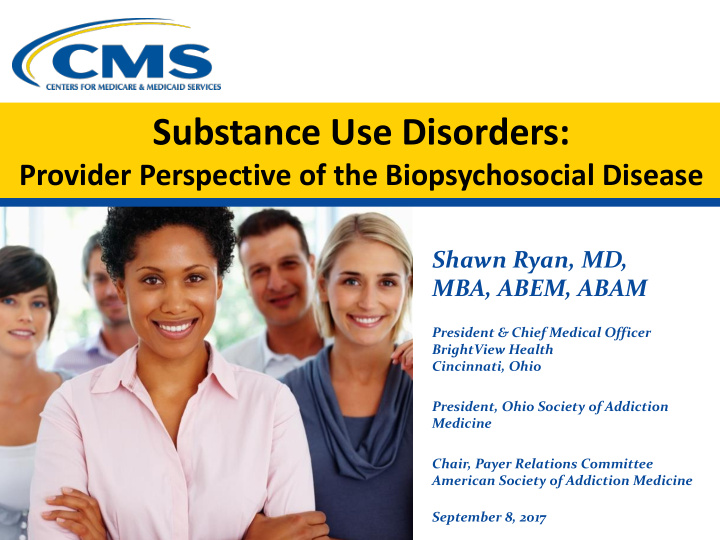



Substance Use Disorders: Provider Perspective of the Biopsychosocial Disease Shawn Ryan, MD, MBA, ABEM, ABAM President & Chief Medical Officer BrightView Health Cincinnati, Ohio President, Ohio Society of Addiction Medicine Chair, Payer Relations Committee American Society of Addiction Medicine September 8, 2017
U.S. Surgeon General, Vivek Murthy MD • An estimated 20.8 million people in our country are living with a substance use disorder. This is similar to the number of people who have diabetes , and 1.5 times the number of people who have all cancers combined . This number does not include the millions of people who are misusing substances but may not yet have a full-fledged disorder. We don't invest nearly the same amount of attention or resources in addressing substance use disorders that we do in addressing diabetes or cancer, despite the fact that a similar number of people are impacted. That has to change .
Agenda • The Issue • The Disease Model • The Treatment Model 3
4 THE ISSUE Substance Use Disorder (SUD) is a chronic, relapsing disease, which has significant economic, personal, and public health consequences. Misuse of and addiction to alcohol, nicotine, and illicit and prescription drugs cost Americans more than $700 billion a year in increased health care costs, crime, and lost productivity Nationally, death rates from Rx Opioid overdoses QUADRUPLED during 1999 – 2013 - MMWR (CDC) CDC estimates over 33,000 people died in 2015 from overdoses involving opioid pain relievers.
5 THE ISSUE - Opioids Americans consume more opioids than any other country in the world
6 THE RESULT
7 THE DISEASE Definition of disease : Any deviation from or interruption of the normal structure or function of any body part, organ, or system that is manifested by a characteristic set of symptoms ASAM definition of the disease of addiction : addiction is a primary, chronic disease of brain reward, motivation, memory and related circuitry. – Dysfunction in these circuits leads to characteristic biological, psychological, social and spiritual manifestations. It fits the definition; and i t can be fatal without treatment.
ASAM Disease Definition… again • Chronic Relapsing Biopsychosocial Disease • Treatment for this Disease must address all three components – Biological - Medical – Psychological – Social
9 TREATMENT – a critical part of the solution Treatment for addiction begins with a comprehensive biopsychosocial assessment – Should be consistent w/ASAM Criteria Comprehensive guidelines for patient placement, continued stay and transfer/discharge – Required in 30+ states – Represents the whole continuum of care
Treatment • Medical – Comprehensive assessment & intake – SAME DAY or NEXT DAY – Outpatient withdrawal management (and ongoing pharmacological management) – Care coordination and monitoring (ex: referrals to other physicians and monitoring of pdmps) • Psychological – Clinical assessment (ASAM PLACEMENT CRITERIA) – Therapy (individual, group, family, etc.) • Social – Case management • Can include all of the following: crisis support, family services, legal services, vocational services, transportation, housing, etc. – Involving social support networks – AA, NA, Peer Support, etc.
11 Reimbursement must align with TREATMENT General categories of reimbursement do not often line up with treatment model – Medical Services Including medications and appropriate testing (without significant barriers) – Psychological Interventions – Social Supports **Consider APM’s (Alternative Payment Models)
12 References • S u r g e o n G e n e r a l s R e p o r t o n A l c o h o l , D r u g s , a n d H e a l t h • A S A M - A m e r i c a n S o c i e t y O f A d d i c t i o n M e d i c i n e • N I D A – N a t i o n a l I n s t i t u t e O n D r u g A b u s e • S A M H S A – S u b s t a n c e A b u s e A n d M e n t a l H e a l t h S e r v i c e s A d m i n i s t r a t i o n • VA C l i n i c a l p r a c t i c e g u i d e l i n e o n S u b s t a n c e U s e D i s o r d e r t r e a t m e n t • C D C . g o v
Recommend
More recommend